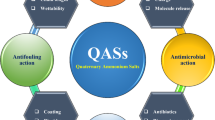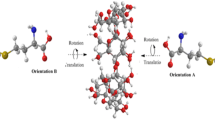Abstract
Amoxicillin (AMOX), a penicillin A, belongs to the β-lactam family It is usually the drug of choice within the class because it is better absorbed, following oral administration, than other β-lactam antibiotics. Its β-lactamase degradation might be prevented by using a molecular [AMOX:β-CD] complex. The aim of this work was to prepare complexes using two methods and then characterize interactions between AMOX and the native β-CD. The extent of complexation in solution has been evaluated by high-performance liquid chromatography (HPLC), nuclear magnetic resonance (NMR), and 2D rotating-frame Overhauser enhancement spectroscopy (2D ROESY). Mass changes (TG), calorimetric effects (DSC), and mass spectrometry (MS) were determined on the same sample under identical conditions using the Skimmer coupling system. Skimmer and infrared spectroscopy (FT-IR) were used to characterize the solid state of the binary system. Complexation of AMOX with β-CD was proven by FT-IR, NMR, DSC, and HPLC. The 2D ROESY spectra did not show any dipolar proton interaction of the AMOX with cyclodextrin. The 1:1 stoichiometry of the complex was obtained by HPLC. The stability constant for AMOX with β-CD was determined to be 1,878 M−1. In the [AMOX:β-CD] complex, the phenyl group is included inside the β-CD, and the ionized carboxyl group on the penam ring forms hydrogen bonds with the secondary hydroxyl groups of another β-CD to keep the complex stable. Preparation methods allowed exactly the same complex.








Similar content being viewed by others
References
Wilson W, Taubert KA, Gewitz M, Lockhart PB, Baddour LM, Levison M, et al. Prevention of infective endocarditis: guidelines from the American Heart Association: a guideline from the American Heart Association Rheumatic Fever, Endocarditis and Kawasaki Disease Committee, Council on Cardiovascular Disease in the Young, and the Council on Clinical Cardiology, Council on Cardiovascular Surgery and Anesthesia, and the Quality of Care and Outcomes Research Interdisciplinary Working Group. J Am Dent Assoc. 2007;138(739–45):747–60.
Bresco-Salinas M, Costa-Riu N, Berini-Aytes L, Gay-Escoda C. Antibiotic susceptibility of the bacteria causing odontogenic infections. Med Oral Patol Oral Cir Bucal. 2006;11:E70–5.
Hansmann Y. Treatment and prevention of Lyme disease. Curr Probl Dermatol. 2009;37:111–29.
Kuriyama T, Williams DW, Yanagisawa M, Iwahara K, Shimizu C, Nakagawa K, et al. Antimicrobial susceptibility of 800 anaerobic isolates from patients with dentoalveolar infection to 13 oral antibiotics. Oral Microbiol Immunol. 2007;22:285–8.
Drissi M, Ahmed ZB, Dehecq B, Bakour R, Plesiat PHocquet D. Antibiotic susceptibility and mechanisms of beta-lactam resistance among clinical strains of Pseudomonas aeruginosa: first report in Algeria. Med Mal Infect. 2008;38:187–91.
Handal T, Olsen I, Walker CB, Caugant DA. Detection and characterization of beta-lactamase genes in subgingival bacteria from patients with refractory periodontitis. FEMS Microbiol Lett. 2005;242:319–24.
Mandsberg LF, Ciofu O, Kirkby N, Christiansen LE, Poulsen HE, Hoiby N. Antibiotic resistance in Pseudomonas aeruginosa strains with increased mutation frequency due to inactivation of the DNA oxidative repair system. Antimicrob Agents Chemother. 2009;53:2483–91.
Shrestha B. Study of beta lactamase activity of Staphylococcus aureus isolated from healthy nasal carriers and hospital isolates. Nepal Med Coll J. 2007;9:107–10.
Voha C, Docquier JD, Rossolini GM, Fosse T. Genetic and biochemical characterization of FUS-1 (OXA-85), a narrow-spectrum class D beta-lactamase from Fusobacterium nucleatum subsp. polymorphum. Antimicrob Agents Chemother. 2006;50:2673–9.
Kaner D, Christan C, Dietrich T, Bernimoulin JP, Kleber BM, Friedmann A. Timing affects the clinical outcome of adjunctive systemic antibiotic therapy for generalized aggressive periodontitis. J Periodontol. 2007;78:1201–8.
Moeintaghavi A, Talebi-ardakani MR, Haerian-ardakani A, Zandi H, Taghipour S, Fallahzadeh H, et al. Adjunctive effects of systemic amoxicillin and metronidazole with scaling and root planing: a randomized, placebo controlled clinical trial. J Contemp Dent Pract. 2007;8:51–9.
Villoria A, Garcia P, Calvet X, Gisbert JP, Vergara M. Meta-analysis: high-dose proton pump inhibitors vs. standard dose in triple therapy for Helicobacter pylori eradication. Aliment Pharmacol Ther. 2008;28:868–77.
Szejtli J. Cyclodextrin Technology. Dordrecht: Kluwer; 1988.
Aleem O, Kuchekar B, Pore Y, Late S. Effect of beta-cyclodextrin and hydroxypropyl beta-cyclodextrin complexation on physicochemical properties and antimicrobial activity of cefdinir. J Pharm Biomed Anal. 2008;47:535–40.
Beni S, Szakacs Z, Csernak O, Barcza L, Noszal B. Cyclodextrin/imatinib complexation: binding mode and charge dependent stabilities. Eur J Pharm Sci. 2007;30:167–74.
Figueiras A, Sarraguca JM, Carvalho RA, Pais AA, Veiga FJ. Interaction of omeprazole with a methylated derivative of beta-cyclodextrin: phase solubility, NMR spectroscopy and molecular simulation. Pharm Res. 2007;24:377–89.
Uekama K, Hirayama F, Irie T. Cyclodextrin drug carrier systems. Chem Rev. 1998;98:2045–76.
Pajatsch M, Andersen C, Mathes A, Bock A, Benz R, Engelhardt H. Properties of a cyclodextrin-specific, unusual porin from Klebsiella oxytoca. J Biol Chem. 1999;274:25159–66.
Pajatsch M, Gerhart M, Peist R, Horlacher R, Boos W, Bock A. The periplasmic cyclodextrin binding protein CymE from Klebsiella oxytoca and its role in maltodextrin and cyclodextrin transport. J Bacteriol. 1998;180:2630–5.
Aki H, Niiya T, Iwase Y, Kawasaki Y, Kumai K, Kimura T. Multimodal inclusion complexes of ampicillin with β-cyclodextrins in aqueous solution. Thermochim Acta. 2004;416:87–92.
Athanassiou G, Michaleas S, Lada-Chitiroglou E, Tsitsa T, Antoniadou-Vyza E. Antimicrobial activity of beta-lactam antibiotics against clinical pathogens after molecular inclusion in several cyclodextrins. A novel approach to bacterial resistance. J Pharm Pharmacol. 2003;55:291–300.
Maffeo D, Leondiadis L, Mavridis IM, Yannakopoulou K. Positive effect of natural and negatively charged cyclodextrins on the stabilization of penicillins towards beta-lactamase degradation due to inclusion and external guest–host association. An NMR and MS study. Org Biomol Chem. 2006;4:1297–304.
The Merck Index. In Windholz M., Budavari S., Blumetti R.F., Otterbein E.S., editors. Tenthed. Merck and Co., Inc. 1996.
Higuchi T, Connors KA. Advances in analytical chemistry and instrumentation. New York: Wiley Interscience; 1965. p. 117–212.
Claridge TDW. High resolution NMR techniques in organic chemistry. Oxford: Pergamon; 1999. p. 320–36.
Uekama K, Hirayama F, Irie T. The new method for determination of the stability constants of cyclodextrin-prostaglandin inclusion complexes by liquid chromatography. Chemistry Letters. 1978; p. 661–664.
Di Stefano R, Scopelliti M, Pellerito C, Fiore T, Vitturi R, Colomba MS, et al. Organometallic complexes with biological molecules. XVII. Triorganotin(IV) complexes with amoxicillin and ampicillin. J Inorg Biochem. 2002;89:279–92.
Fogazzi GB, Cantu M, Saglimbeni L, Daudon M. Amoxycillin, a rare but possible cause of crystalluria. Nephrol Dial Transplant. 2003;18:212–4.
Mc Millan I, Stoodley RJ. A novel rearrangement of methyl-6 chloropenicillanate. Tetrahydron Lett. 1966;11:1205–10.
Marciniec B, Plotkowiak Z, Wachowski L, Kozak M, Popielarz-Brzezinska M. Analytical study of γ-irradiated antibiotics in the solid state. J Therm Anal Calorim. 2002;68:423–36.
Szejtli J. Inclusion compounds: physical properties and applications. In: Atwood JL, Davies JE, MacNicol DD, editors. Inclusion compounds, vol. 3. London: Academic; 1984. p. 331–89.
Nepogodiev SA, Stoddart JF. Cyclodextrin-based catenanes and rotaxanes. Chem Rev. 1998;98:1959–76.
Acknowledgments
We are very grateful to Professor Mutzenhardt (Laboratoire de Méthodologie en RMN, Faculté des Sciences et Techniques, Nancy) for his help in performing 2D ROESY analysis. We also thank Professor Marsura for his help and Mme Anne Marie Canziani for her technical assistance.
Author information
Authors and Affiliations
Corresponding author
Rights and permissions
About this article
Cite this article
Bisson-Boutelliez, C., Fontanay, S., Finance, C. et al. Preparation and Physicochemical Characterization of Amoxicillin β-cyclodextrin Complexes. AAPS PharmSciTech 11, 574–581 (2010). https://doi.org/10.1208/s12249-010-9412-1
Received:
Accepted:
Published:
Issue Date:
DOI: https://doi.org/10.1208/s12249-010-9412-1




